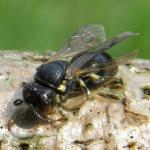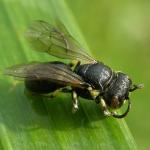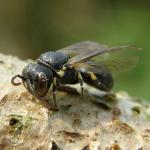Hylaeus spilotus Forster, 1871; H. euryscapus misident.; H. masoni (Saunders, E. 1894).
Formerly known as Hylaeus spilotus Forster, 1871 - see recent name changes. A close relative of Hylaeus dilatatus but readily distinguished in both sexes by the highly polished surface (devoid of fine microreticulation) between the mesontal punctures. There are other distinguishing characters involving the shape and patterning of the antennal scapes in the males.
Southern England, from East Kent to Dorset, and north to Gloucestershire. Also known from the Channel Islands (Jersey (Saunders 1902; Richards 1979). This is mainly a south-western European and North-west African species (Koster 1986).
Not listed in Shirt (1987) or by Falk (1991).
Confined to coastal dunes and shingle (as in the Netherlands).
Univoltine; late June to the end of August.
Apparently only a single nest has been found in Britain. This was in a burrow excavated in loose sand on the dunes at Camber Sands, East Sussex (M Edwards, pers. comm.). In France, nests have been found in the dead stems of bramble (Rubus), a sea holly (Eryngium) and grape (Vitis vinifera) (Janvier 1972).
Biting stonecrop (Sedum acre), bramble (Rubus fruticosus agg.), carrot (Daucus carota), creeping thistle (Cirsium arvense), fennel (Foeniculum vulgare), a hawkweed (Hieracium sp.), a mayweed (Matricaria sp.), a ragwort (Senecio sp.), sea spurge (Euphorbia paralias) and yarrow (Achillea millefolium).
None known.
Proofed: January 2013




